Application stage and doses of glyphosate in control, production of fruits and seeds of Solanum americanum
César Tiago Forte1, Ubirajara Russi Nunes2, Millena Candeia Dutra1, Emely Vitória Bona1, Maurício Albertoni Scariot1, Michele Renata Revers Meneguzzo1 and Leandro Galon3
1Centro Universitário IDEAU, Getúlio Vargas, RS, Brasil
2Universidade Federal de Santa Maria, Santa Maria, RS, Brasil
3Universidade Federal da Fronteira Sul, Erechim, RS, Brasil
Abstract
Weeds interfere with crops of economic interest, and their control has been threatened due to how management practices are being applied, increasing cases of resistance to herbicides. The objective of the study was to evaluate the influence of the application stage and doses of glyphosate herbicide on the development characteristics of Solanum americanum and the production of fruits and seeds. The experiment was characterized as bifactorial (doses x application stages). The first factor was composed of 7 doses of glyphosate herbicide (0, 45, 90, 180, 360, 720 and 1440 g e.a ha-1) applied when there were 5 leaves and at flowering (first open flower), simulating application at the ideal time and late, respectively. The variables evaluated were control at 28 and 56 days after application of treatments (DAA), 28 DAA; plant height (cm), number of fruits per plant, seeds per fruit, total fruit production, plant dry matter and seed germination at the end of the experiment were measured. The application of glyphosate in the initial stages of the weed improved control when compared to the application at the flowering stage of the species, resulting in a lower dose of glyphosate for control. Anticipating control drastically reduced plant height, production of fruits, seeds, and dry matter mass of S. americanum, but without affecting seed germination. When applied at the 5-leaf stage, 25% (180 g e.a ha-1) of the recommended dose of glyphosate is enough for the S. americanum species not to produce descendants.
Highlighted Conclusions
1. All evaluated factors were reduced with an increase in the dose of glyphosate herbicide.
2. The best controls were observed at the weed stage of up to 5 leaves.
3. The flowering stage of the American black nightshade weed requires 4 times more glyphosate to obtain adequate levels of control.
Communications in Plant Sciences | 2023 | vol.13 | p.043-049
DOI: 10.26814/cps2023006 | Article code: cps2023006
Keywords: American black nightshade, Seed bank, Ideal application stage, Chemical control
Correspondence to: César Tiago Forte <cesartiagoforte@hotmail.com>
Submission on October16, 2023 | First Publication on January 18, 2024 | Open Access
Authors declared no conflict of interest
Article licensed under a Creative Commons Attribution-NonCommercial 4.0 International
Application stage and doses of glyphosate in control, production of fruits and seeds of Solanum americanum
INTRODUCTION
Solanum americanum Mill. is a weed belonging to the Solanaceae family, that infests annual grain crops, vegetable and fruit crops (Lorenzi et al. 2017). In addition to competing with crops of agronomic interest, the species can be a host for diseases such as Corynespora cassiicola, which infests soybean crops (Pereira and May-de-mio 2019). The main way to control S. americanum is through the application of herbicides. The herbicides registered in Brazil for post-emergence control of S. americanum include 2,4-D, fomesafen, lactofen, paraquat and mostly glyphosate, the active ingredient with the largest number of commercial products for the control of this species (Agrofit 2019).
Glyphosate is the most widely used herbicide worldwide, broad-spectrum, systemic, non-selective and post-emergent, much of this use is associated with the increase in genetically modified crops, with resistance to the herbicide (Baylis et al. 2000). This herbicide combines several important agronomic factors, such as effectiveness in controlling mono and dicotyledons, feasability, reduced toxicity to animals, relatively low cost due to ease of synthesis (Duke et al. 2008). However, with the unrestrained use, some weed species have acquired resistance to the product. Already 97 cases of resistance have been recorded (Heap and Duke 2018), mainly for Conyza sp. (Dennis et al. 2016), Digitaria insularis (Lopez-Ovejero et al. 2017), Eleusine indica (Jalaludin et al. 2015), among others.
Doses of glyphosate may vary from species to species, crop and weed development stage (Agrofit 2019). Many of the control gaps are due to the weed stage at the time of herbicide application, which can even select the resistant plants to the active ingredient (Rios et al. 2016). Late applications allow greater weed reserves accumulation, which reduces the efficiency of herbicides and consequently can increase the interference of weeds in crops (Dennis et al. 2016). Rios et al. (2016), reported that both glyphosate and glufosinate, applied to isolates, are effective in controlling Amaranthus palmeri if applied before the 8 to 10-leaf stage. The chemical tool, by herbicides, is an important management strategy when used correctly, it ensures higher crop yields and reduces the restitution of the weed seed bank in the soil (Mayerová et al. 2018). Other research shows that simple crop management and use of conservation practices (direct planting) can significantly reduce the weed seed bank, including for S. americanum (Forte et al. 2018). Management practices that promote the replenishment of weed seeds in the soil are undesirable for advancing control strategies (Westwood et al. 2018).
The hypothesis that was tested is that the late application of glyphosate to S. americanum would result, even at high doses, in inefficient plant control and the possibility of producing descendants to restitute the seed bank. Therefore, the objective of the study was to evaluate the influence of the application stage and doses of the glyphosate herbicide on the development characteristics of S. americanum and the production of fruits and seeds.
MATERIAL AND METHODS
The studies were conducted in a greenhouse and in the laboratory of the Sustainable Management of Agricultural Systems (MASSA) research group, at the Federal University of Fronteira Sul – Erechim Campus – RS.
Vegetal material. S. americanum seeds were collected manually, in fallow areas, next to commercial corn and soybean crops. The collections were carried out in Santa Maria – RS (29° 42′ 55″ S e 53° 44′ 13″ O). To obtain plant uniformity, the sowing of S. americanum was first carried out in the laboratory, having previously overcome its dormancy by alternating temperatures and immersing the seeds for 21h in 0.2% KNO3 (Forte et al. 2019). After germination (25 days after emergence), at seedling stage, plants were transferred into experimental units, consisted of 8L plastic, filled with 25% of substrate and 75% of soil. The EUs were irrigated daily to maintain the humidity necessary for growth and development of the species.
Experimental design. The experiment was conducted in a randomized block design, with four replications, in a 7 x 2 factorial scheme (doses x application stages). The dose factor was composed of 7 concentrations of glyphosate herbicide (0, 45, 90, 180, 360, 720 and 1440 g e.a ha-1), being 720 g e.a ha-1 the recommended control dose for the stage. The application stage factors were 5 leaves and at flowering (first flower open), simulating application at the ideal time and late, respectively. At the predefined stages, the herbicides were applied with a backpack sprayer pressurized by CO2, equipped with TeeJet XR – 110.02 flat jet fan tips, spaced 0.5 m apart, calibrated for an application rate of 150 L ha-1 and pressure of work of 1.62 kgf cm-2.
Evaluated Variables. Assessments of S. americanum control were carried out at two moments, 28 and 56 days after application of treatments (DAA), according to the criteria established by SBCPD (1995). At 28 DAA, the height of the plants (cm) was measured, from the base of the plant to the top, using a graduated ruler. The number of fruits plant-1 was evaluated by counting from the beginning to the end of the species’ development stage. Seeds were counted per fruit, taking samples of 10 fruits per experimental unit. The determination of fruit and seed production was carried out by counting all the fruits of the plants, as well as the total number of seeds produced per fruit and plant dry matter at the end of the experiment (g plant-1), this determination was carried out in a forced air circulation oven at 65 ºC for 72 h. Seed germination tests were carried out in a germination box, under three sheets of germination test paper moistened with distilled water in an amount equivalent to 2.5 times the mass of the dry paper and at an alternating temperature of 20 – 30°C, 12 h for each temperature. For each germination box, 50 seeds were set. To be considered a germinated seed, the seed had a two-millimeter-long radicle, with germination assessments being carried out daily.
Statistical Analysis. The normality of errors and the homogeneity of residual variances were verified. For variables given in percentage (control and seed germination) the data were transformed to arc.sin√%/100. After confirmation, an analysis of variance and an F test were performed. If the qualitative factor (stages) was significant, it was compared using Student’s t test and the quantitative factor (doses of glyphosate) using linear or non-linear regressions. All statistical tests were performed with a 5% error probability.
RESULTS AND DISCUSSION
Given the results obtained, it was possible to verify that all the variables evaluated showed a significant interaction, except for seed germination of S. americanum (Figures 1 to 6).
Early-stage weeds can be more easily controlled with the use of herbicides, regardless of the assessment period (Figure 1). In the 28 days after application (DAA) evaluation, the control of S. americanum was greater than 80%. However, when the dose of 180 g e.a ha-1 was applied at the 5-leaf stage, when the same dose was applied at flowering, the control did not exceed 30% (Figure 1A). The necessary amount of glyphosate to achieve 80% control would be close to 1040 g e.a ha-1, when applied at flowering (Figure 1B), also illustrated in Figure 6. Similar results were found for Conyza bonariensis, in which a dose of 900 g e.a ha-1 demonstrated severe symptoms in the “rosette” stage, not observed in the more advanced stage of the species (Okumu et al. 2019).
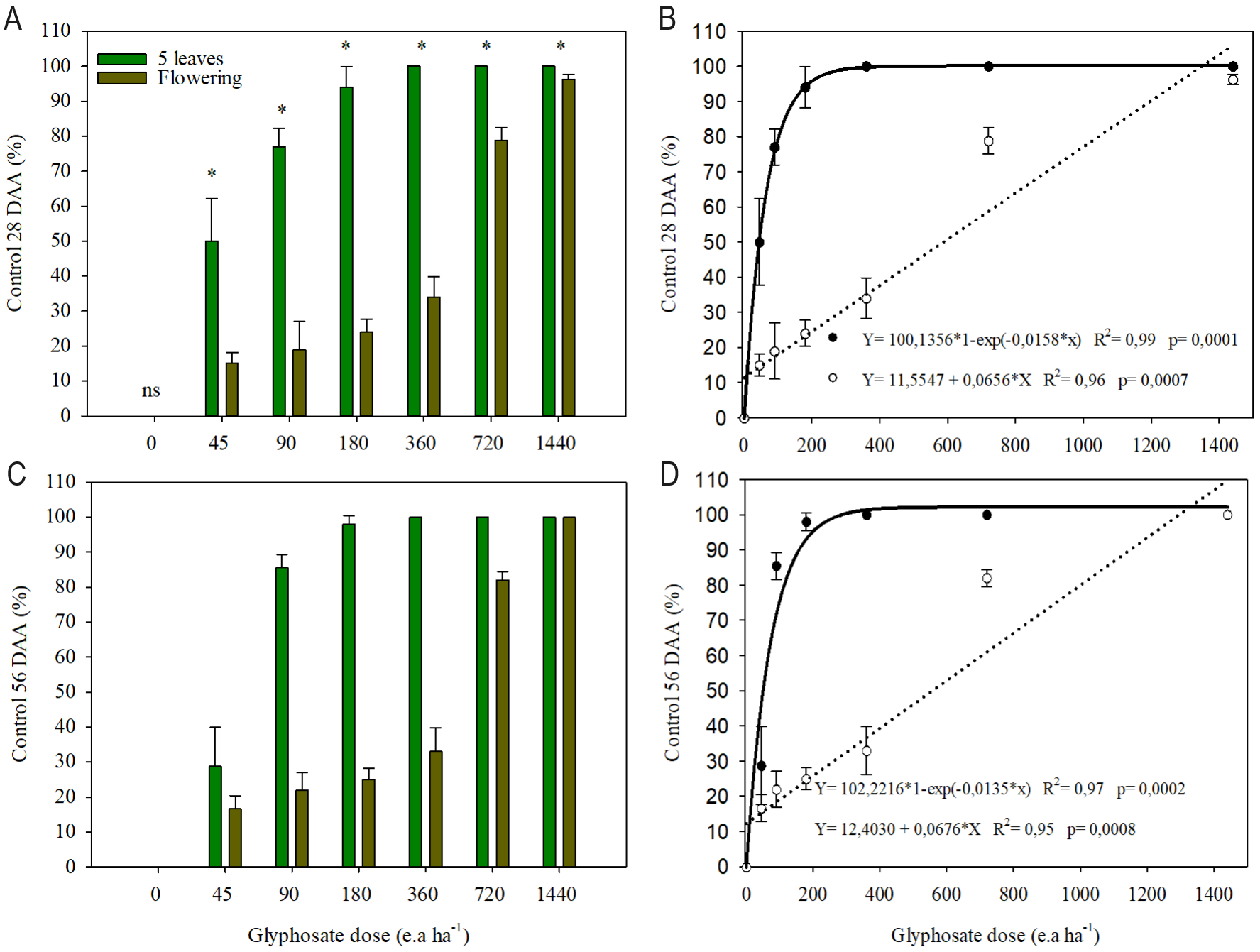
Figure 1. Solanum americanum control (%) at 28 and 56 days after the application of different doses (45, 90, 180, 360, 720 and 1440 g e.a ha-1) of Glyphosate herbicide at different weed development stadiums (5 leaves and the beginning of flowering). Green and closed circle columns represent the application at the 5-leaf stage and column in brown and open circle, in flowering. Average is represented by the control and standard deviation of 5 independent biological repetitions. *Difference for the control in each season with the same dose of herbicide by T test, 5% probability of error.
In the glyphosate 56 DAA evaluation, the results were like those found in the 28 DAA. The main difference is connected to the dose observed for 1440 g e.a ha-1, which in this evaluation had total control of the S. americanum plants, at the stage of flourishing. This result indicates that even the dose of 1440 (twice that recommended for the control of S. americanum) to the plants was only completely controlled after 28 DAA, this longer period to obtain maximum control may result in competition between the weed and the crop, when in a field situation. The importance of anticipating control (early stages) stands out, favoring increased control efficiency, reinforcing the importance of application to plants with smaller reserves (Shrestha et al. 2007).
Glyphosate application to S. americanum at flowering stage provided greatest plant height at all doses tested, when compared to the application at the 5 -leaf stage (Figure 2A). For the recommended dose of control (720 g e.a ha-1), the average plant height was 46.5 cm for application at the beginning of flowering, while for application at the 5-leaf stage, growth was paralyzed (Figure 2B). The application of herbicides in the most advanced weed stages, in addition control decrease, can reduce yields of economic interest crops (Craigmyle et al. 2013).
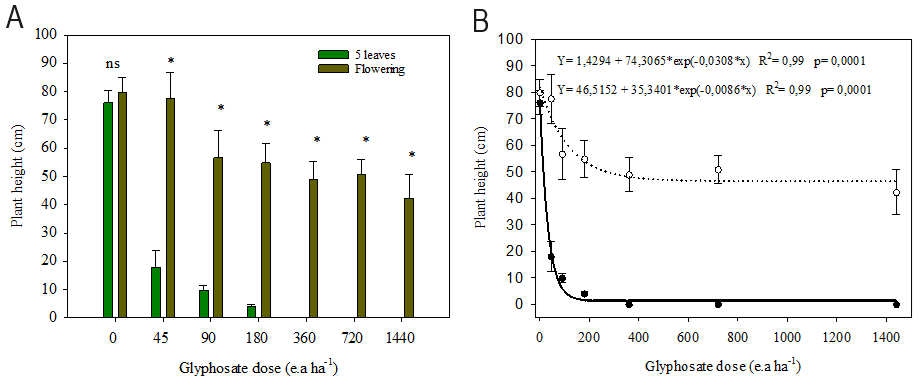
Figure 2. Solanum americanum plant height (cm), 56 days after the application of different doses (45, 90, 180, 360, 720 and 1440 g e.a. ha-1) of Glyphosate herbicide at different weed development stages (5 leaves and beginning of flowering). Green and closed circle columns represent the application at the 5 -leaf stage and column in brown and open circle at flowering. Average is represented by the control and standard deviation of 5 independent biological repetitions. *Difference for the control in each season with the same dose of herbicide by T test, 5% probability of error.
Fruit production can be directly related to seed production, and it is essential to understand how to manage the seed bank of these species (Westwood et al. 2018). Therefore, it is found that up to the 360 g dose e.a ha-1, when application was at flowering stage, the S. Americanum plants produced more fruits compared to the application at the 5-leaf stage (Figure 3A). It is noteworthy that there was an observed difference when 0 g e.a ha-1 of glyphosate was applied, because the plants were managed at different periods, enabling the applications to be done at the same time. It is likely that the plants of S. americanum respond to the accumulation of degrees and therefore have differences in the number of fruits.
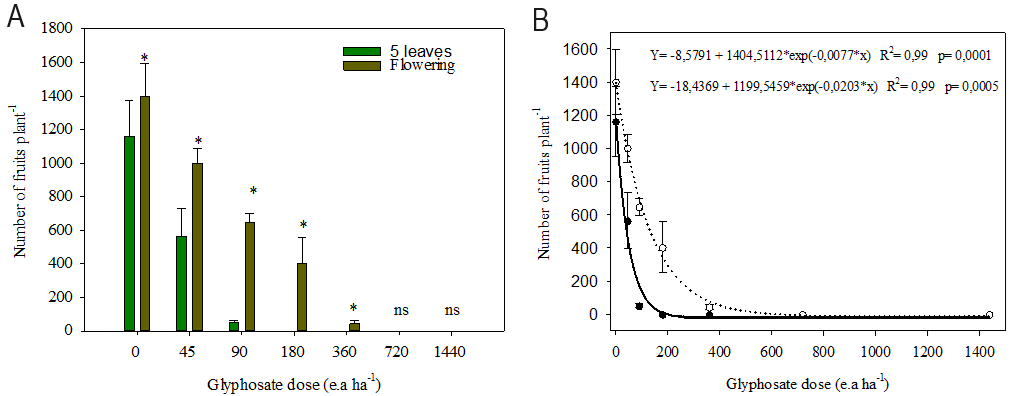
Figure 3. Number of fruits plant-1 after applying doses (45, 90, 180, 360, 720 and 1440 g e.a ha-1) of glyphosate herbicide at different weed development stages (5 leaves and beginning of flowering). Green and closed circle columns represent the application at the 5 -leaf stage and brown and open circle column at flowering. Average is represented by the control and standard deviation of 5 independent biological repetitions. *Difference for the control in each season with the same dose of herbicide by T test, 5% probability of error.
When applying glyphosate to the two developmental stages of S. americanum, it was not possible to detect differences in seed fruit-1 production. The only difference in seed production per fruit was observed at the 5-leaf stage, for doses of 0 and 180 g e.a ha-1, possibly justified by the difference in sowing time and the complete death of plants, respectively (Figure 4A). Seed production is directly linked to replacement of seeds in the soil, being the application of herbicides an important management strategy (Mayerová et al. 2018).
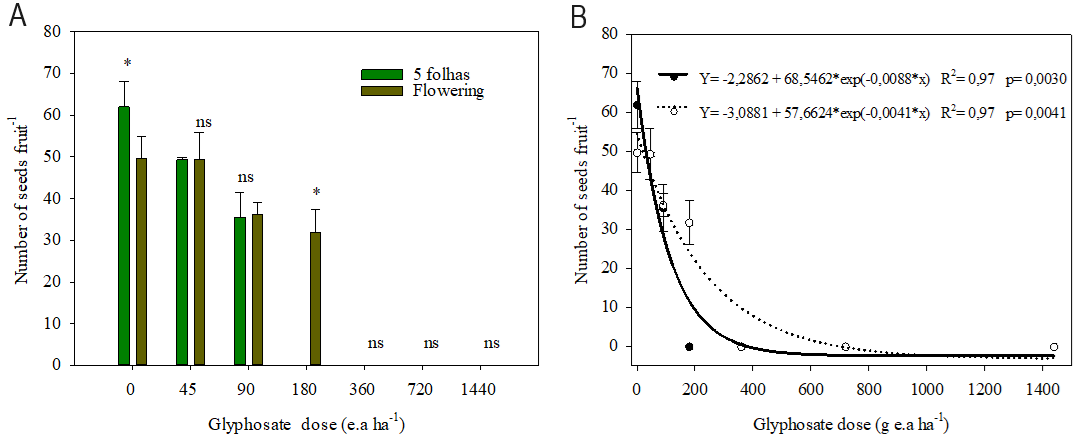
Figure 4. Number of seeds fruit-1 after application of different doses of glyphosate (45, 90, 180, 360, 720 and 1440 g e.a ha-1) of the herbicide glyphosate at different stages of weed development (5 leaves and beginning of flowering). Columns in green and closed circle represent the application at the 5-leaf stage and columns in brown and open circle at flowering. Means are represented by the control and standard deviation of 5 independent biological replicates. *Difference for the control in each season with the same dose of herbicide using the T test, with a 5% probability of error.
In Figure 4B, the reduction in seed fruit-1 production is graphically represented using decreasing exponential equations, as the dose of glyphosate increases. It is important to highlight that ¼ of the recommended herbicide dose (180 g e.a ha-1) resulted in a total reduction in fruit/seed production when applications were carried out on plants with 5 leaves. For application to flowering plants, only doses of 360, 720 and 1440 g e.a ha-1 completely reduced the production of fruits and seeds (Figures 3 and 4). Similar results were found for the species Euphorbia heterophylla, which only the highest dose of glyphosate had effective control when applied in the most advanced stages of development (Lati et al. 2019). The same authors concluded that the effectiveness of herbicides was dependent on the growth stage of the weed at the time of application of the products, corroborating the observed in the present study.
The estimated total production of seeds plant-1, without application of glyphosate, can reach an average of 72,000, according to the data observed in the present study. It is important to highlight that the conditions were controlled, and the experimental units may have limited plant growth, which may have influenced the real potential for seed production. However, it is undeniable that the species can produce thousands of descendants, contributing to the replacement of seeds in the soil seed bank. Studies with the species S. ptycanthum, the same genus as the species in the present study, indicate that approximately 5% of the seeds produced can establish new plants in the next year of cultivation (Scursoni et al. 2007). For S. americanum, if 5% of the seeds produced could generate a new plant in the system, a total of 3,600 new individuals would be generated in the next growing season.
The study showed that in all doses of glyphosate there was superiority in the accumulation of plant dry matter for the shoot of S. americanum, when the application was done at the beginning of the species’ flowering (Figure 4A). While at a dose of 90 g e.a ha-1 of glyphosate (application at the beginning of flowering) the dry matter mass was above 80 g plant-1, at the same dose for application at the 5-leaf stage, S. americanum plants reduced to an average of 5 g. These results reinforce the justification for controlling this species in the early stages of development. The decrease in weed control at more advanced stages may be related to the higher rate of herbicide degradation and lower absorption by plants (Lati et al. 2012).
The difference observed for the stages, at dose zero, may probably be related to the fact that they were established at different times, aiming to carry out glyphosate applications under the same soil and climate conditions.
When analyzing the quantitative factor (doses of glyphosate), it is observed that for every 100 g e.a ha-1 of glyphosate added, the reduction was 4.8 g plant-1. Increasing herbicide dose linearly reduced the dry matter mass of S. americanum, for application at the beginning of flowering. When the application was done at stages up to 5 leaves, it was possible to see that 100 g e.a were sufficient to reduce 54.7 g plant-1, which is an 85% reduction when compared to the control without application (Figure 5B).
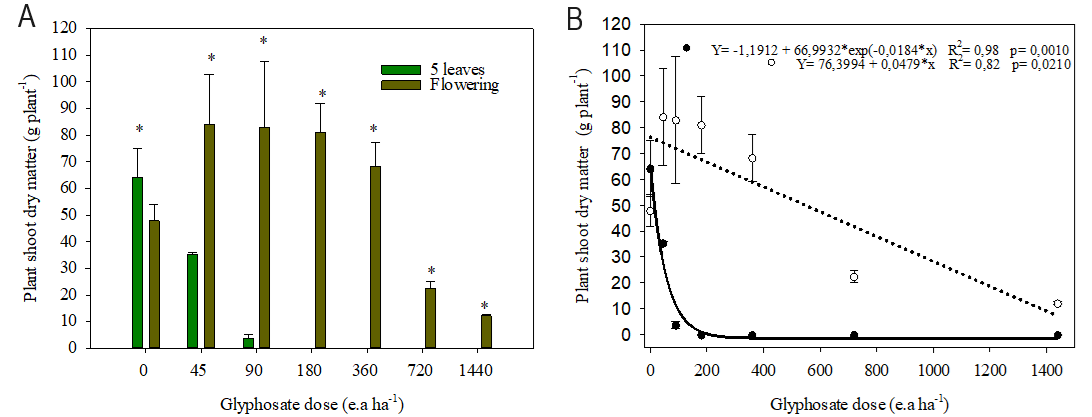
Figure 5. Plant shoot dry matter (g plant-1) of S. americanum after the application of doses (45, 90, 180, 360, 720 and 1440 g e.a ha-1) of glyphosate herbicide at different stages of plant development (5 leaves and beginning of flowering). Columns in green and closed circle represent the application at the 5-leaf stage and columns in brown and open circle at the beginning of flowering. Means are represented by the control and standard deviation of 5 independent biological replicates. *Difference for the control in each season with the same dose of herbicide using the t test, with a 5% probability of error.
The S. americanum seeds, produced by plants that received different doses of glyphosate and application times, did not show any change in germination with the application of the different treatments (at doses zero to 180 g e.a ha-1) (Figure 6A and B). The differences found between the two application times (180 g e.a ha-1) are due to the lack of seed production for application at the 5-leaf stage (Figure 6A). Thus, glyphosate can interfere with the production of weed seeds (Scursoni et al. 2007), however, applications of different doses at different stages do not interfere with the seed germination percentage of S. americanum (Figure 6).
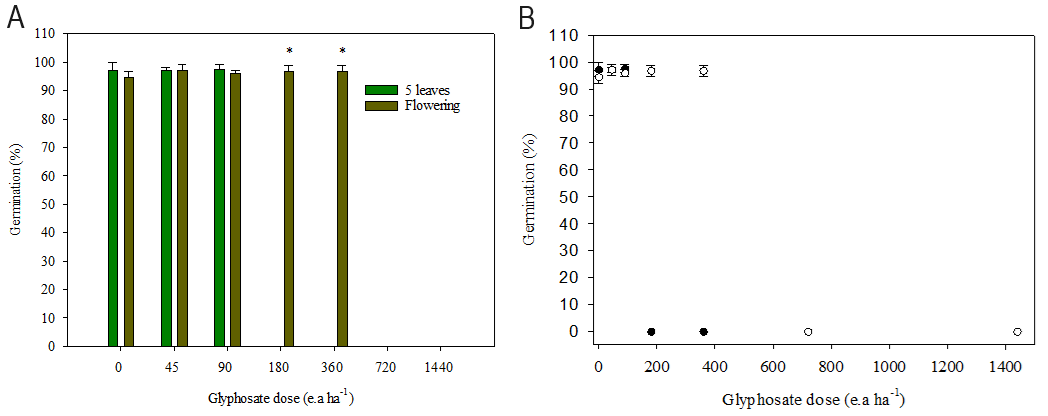
Figure 6. Seed germination (%) of S. americanum after application of glyphosate doses (45, 90, 180, 360, 720 and 1440 g e.a. ha-1) at different stages of weed development (5 leaves and beginning of flowering). Columns in green and closed circle represent the application at the 5-leaf stage and columns in brown and open circle, at the beginning of flowering. Means are represented by the control and standard deviation of 5 independent biological replicates. *Difference for the control in each season with the same dose of herbicide using the T test, with a 5% probability of error.
Often, there are weed control failures, and these are wrongly connected to supposed herbicide resistance. Figure 7 shows an illustrative summary of the studies carried out on the control of S. americanum at the ideal time and out of the ideal stage (flowering). The importance of adequate management is highlighted to avoid replacement of seeds for the seed bank, the onset of resistance levels and losses due to competition with crops of economic interest.
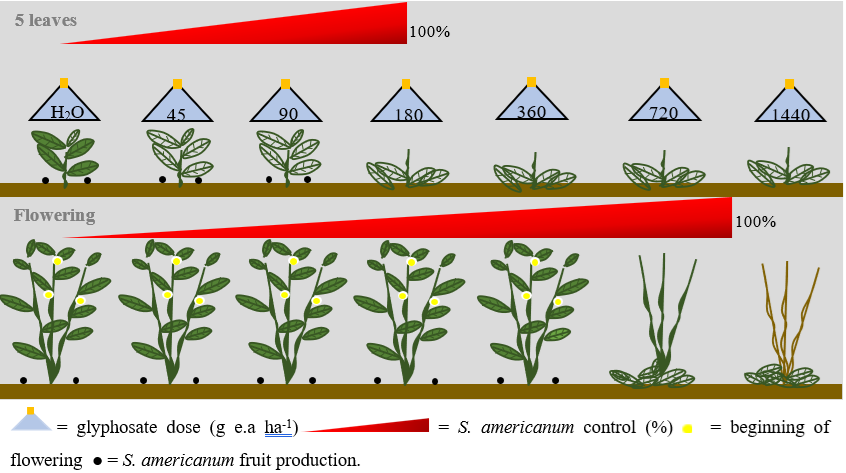
Figure 7. Scheme representing the main results found with the application of different doses of glyphosate and growth stage of S. americanum. The stages are represented by the two plant models, 3-5 leaves and beginning of flowering. Columns in green and a closed circle represent the application at the 5-leaf stage and columns in brown and an open circle at flowering. Means are represented by the control and standard deviation of 5 independent biological replicates. *Difference for the control in each season with the same dose of herbicide using the T test, with a 5% probability of error.
In conclusion, the increase in the dose of glyphosate provided greater control, decreasing plant height, number of fruits and dry matter of the shoot of S. americanum, when the application occurred at stages up to 5 leaves. For application at stages up to 5 leaves, 180 g e.a ha-1 of glyphosate is sufficient for the S. americanum species not to produce descendants. For the flowering stage, the dose should be 720 g e.a ha-1.
Acknowledgments
The authors thank the CNPq for the financial support of research and scholarships.
Funding
This research was financially supported by the National Council for Scientific and Technological Development (CNPq) process number – 406221/2016-2.
References
- AGROFIT – Sistema de Agrotóxicos fitossanitários. Disponível em: <http://extranet.agricultura.gov.br/agrofit_cons/principal_agrofit_cons>. Acesso em: 14 de julho de 2019.
- Baylis AD. 2000. Why glyphosate is a global herbicide: strengths, weaknesses and prospects. Pest Management Science 56: 299-308.
- Craigmyle et al. 2013. Influence of weed height and glufosinate plus 2,4-D combinations on weed control in soybean with resistance to 2,4-D. Weed Technologv 27: 271-280.
- Dennis M et al. 2016. Growth stage, temperature, and time of year affects the control of glyphosate-resistant and glyphosate-paraquat resistant Conyza bonariensis with saflufenacil. Crop Protection 81: 129-137.
- Duke SO and Powles SB. 2008. Glyphosate: a once in a century herbicide. Pest management science 64: 319-325.
- Duke SO. 2014. Biotechnology: Hebicide-Resistant crops. Encyclopedia of Agriculture and Food Systems v. 2.
- Forte CT et al. 2018a. Cultivation systems, vegetable soil covers and their influence on the phytosocyology of weeds. Planta Daninha 36: 1-15.
- Forte CT et al. 2019. Chemical and environmental factors driving Solanum americanum Mill. Germination. Weed Biology and Management 19: 113-120.
- Forte CT et al. 2018b. Soil management systems and their effect on the weed seed bank. Pesquisa Agropecuária Brasileira 53: 435-442.
- Heap I and Duke SO. 2018. Overview of glyphosate-resistant weeds worldwide. Pest Managment Science 74: 1040-1049.
- Jalaludin A et al. 2015. Multiple resistance across glufosinate, glyphosate, paraquat and ACCase-inhibiting herbicides in an Eleusine indica population. Weed Research 55: 82-89.
- Lati RN et al. 2019. Wild poinsettia biology and management–determining optimal control with herbicides and propane flaming. Crop Protection 115: 20-26.
- Lati RN et al. 2012. Effect of tuber density and trifloxysulfuron application timing on purple nutsedge (Cyperus rotundus) control. Weed Science 60: 494-500.
- Lopez-Ovejero RF et al. 2017. Frequency and dispersal of glyphosate-resistant sourgrass (Digitaria insularis) populations across brazilian agricultural production areas. Weed Science 65: 285-294.
- Lorenzi H. 2017. Manual de Identificação e de Controle de Plantas Daninhas: plantio direto e convencional. Ed. 7, Plantarum, Nova Odessa, 338p.
- Mayerová M et al. 2018. Effect of chemical weed control on crop yields in different crop rotations in a long-term field trial. Crop Protection 114: 215-222.
- Okumu MN et al. 2019. Growth-stage and temperature influence glyphosate resistance in Conyza bonariensis (L.) Cronquist. South African Journal of Botany 121: 248-256.
- Pereira WV and May-de-Mio LL. 2019. First report of Corynespora cassiicola causing leaf spot on Solanum americanum in Brazil. Journal of Plant Pathology 101: 755.
- Perry ED et al. 2019. Product concentration and usage: Behavioral effects in the glyphosate market. Journal of Economic Behavior & Organization 58: 543-559.
- Rios SI et al. 2016. Tolerance of Amaranthus palmeri populations from California to postemergence herbicides at various growth stages. Crop Protection 87: 6-12.
- SBCPD – Sociedade Brasileira da Ciência das Plantas Daninhas (1995). Procedimentos para instalação, avaliação e análise de experimentos com herbicidas. Londrina, SBCPD. 42p.
- Scursoni JA et al. 2007. Weed escapes and delayed weed emergence in glyphosate-resistant soybean. Crop Protection26: 212-218.
- Shrestha A et al. 2007. Growth stage influences level of resistance in glyphosate-resistant horseweed. California Agriculture 61: 67-70.
- Vangessei MJ et al. 2009. Influence of glyphosate-resistant horseweed (Conyza canadensis) growth stage on response to glyphosate applications. Weed Science 23: 49-53.
- Westwood JH et al. 2018. Weed Management in 2050: Perspectives on the Future of Weed Science. Weed Science 66: 275-285.
- Yang X et al. 2015. Short-term transport of glyphosate with erosion in Chinese loess soil-a flume experiment. Science of The Total Environment 512-513: 406-414.
